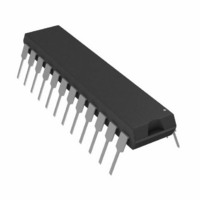AD7537KNZ Analog Devices Inc, AD7537KNZ Datasheet - Page 7

AD7537KNZ
Manufacturer Part Number
AD7537KNZ
Description
IC DAC 12BIT DUAL MULT 24DIP
Manufacturer
Analog Devices Inc
Datasheet
1.AD7537JNZ.pdf
(8 pages)
Specifications of AD7537KNZ
Data Interface
Parallel
Settling Time
250µs
Number Of Bits
12
Number Of Converters
2
Voltage Supply Source
Single Supply
Power Dissipation (max)
24mW
Operating Temperature
-40°C ~ 85°C
Mounting Type
Through Hole
Package / Case
24-DIP (0.300", 7.62mm)
Resolution (bits)
12bit
Sampling Rate
667kSPS
Input Channel Type
Parallel
Supply Current
2mA
Digital Ic Case Style
DIP
No. Of Pins
24
Number Of Channels
2
Resolution
12b
Conversion Rate
667KSPS
Interface Type
Parallel
Single Supply Voltage (typ)
12/15V
Dual Supply Voltage (typ)
Not RequiredV
Architecture
R-2R
Power Supply Requirement
Single
Output Type
Current
Integral Nonlinearity Error
±0.5LSB
Single Supply Voltage (min)
10.8V
Single Supply Voltage (max)
16.5V
Dual Supply Voltage (min)
Not RequiredV
Dual Supply Voltage (max)
Not RequiredV
Operating Temp Range
-40C to 85C
Operating Temperature Classification
Industrial
Mounting
Through Hole
Pin Count
24
Package Type
PDIP
Lead Free Status / RoHS Status
Lead free / RoHS Compliant
Lead Free Status / RoHS Status
Lead free / RoHS Compliant, Lead free / RoHS Compliant
Available stocks
Company
Part Number
Manufacturer
Quantity
Price
REV. 0
APPLICATION HINTS
Output Offset: CMOS D/A converters in circuits such as Fig-
ures 4 and 5 exhibit a code dependent output resistance which
in turn can cause a code dependent error voltage at the output
of the amplifier. The maximum amplitude of this error, which
adds to the D/A converter nonlinearity, depends on V
V
operation, it is recommended that V
(25
Suitable op amps are the AD711C and its dual version, the
AD712C. These op amps have a wide bandwidth and high slew
rate and are recommended for wide bandwidth ac applications.
AD711/AD712 settling time to 0.01% is typically 3 s.
Temperature Coefficients: The gain temperature coefficient
of the AD7537 has a maximum value of 5 ppm/ C and typical
value of 1 ppm/ C. This corresponds to worst case gain shifts of
2 LSBs and 0.4 LSBs respectively over a 100 C temperature
range. When trim resistors R1 (R3) and R2 (R4) are used to ad-
just full scale range as in Figure 4, the temperature coefficient of
R1 (R3) and R2 (R4) should also be taken into account. For
further information see “Gain Error and Gain Temperature Co-
efficient of CMOS Multiplying DACs”, Application Note, Pub-
lication Number E630c-5-3/86 available from Analog Devices.
High Frequency Considerations: AD7537 output capaci-
tance works in conjunction with the amplifier feedback resis-
tance to add a pole to the open loop response. This can cause
ringing or oscillation. Stability can be restored by adding a
phase compensation capacitor in parallel with the feedback re-
sistor. This is shown as C1 and C2 in Figures 4 and 5.
Feedthrough: The dynamic performance of the AD7537 de-
pends upon the gain and phase stability of the output amplifier,
together with the optimum choice of PC board layout and de-
coupling components. A suggested printed circuit layout for
Figure 4 is shown in Figure 8 which minimizes feedthrough
from V
MICROPROCESSOR INTERFACING
The byte loading structure of the AD7537 makes it very easy to
interface the device to any 8-bit microprocessor system. Figures
9 and 10 show two interfaces: one for the MC6809 and the
OS
is the amplifier input offset voltage. To maintain specified
10
REFA
–6
Figure 8. Suggested Layout for AD7537
) (V
, V
REFB
REF
) over the temperature range of operation.
to the output in multiplying applications.
OS
be no greater than
OS
, where
–7–
other for the MC68008. Figure 11 shows how an AD7537 sys-
tem can be easily expanded by tying all the UPD lines together
and using a single decoder output to control these. This ex-
panded system is shown using a Z80 microprocessor but it is
just as easily configured using any other 8-bit microprocessor
system. Note how the system shown in Figure 11 produces 4
analog outputs with a minimum amount of hardware.
Figure 10. AD7537–MC68008 Interface
Figure 11. Expanded AD7537 System
Figure 9. AD7537–MC6809 Interface
AD7537










